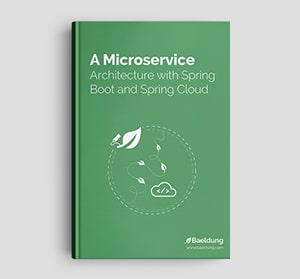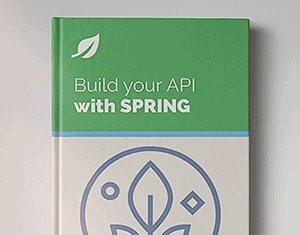1. Overview
In this quick tutorial, we’ll look at the serialization and deserialization of Java maps using Jackson.
We’ll illustrate how to serialize and deserialize Map<String, String>, Map<Object, String>, and Map<Object, Object> to and from JSON-formatted Strings.
How to serialize Maps with a null key or null values using Jackson.
How to serialize and deserialize an Enum as a JSON Object using Jackson 2.
This short tutorial shows how the Jackson library can be used to serialize Java object to XML and deserialize them back to objects.
2. Maven Configuration
<dependency>
<groupId>com.fasterxml.jackson.core</groupId>
<artifactId>jackson-databind</artifactId>
<version>2.17.2</version>
</dependency>
We can get the latest version of Jackson here.
3. Serialization
Serialization converts a Java object into a stream of bytes, which can be persisted or shared as needed. Java Maps are collections that map a key Object to a value Object, and are often the least intuitive objects to serialize.
3.1. Map<String, String> Serialization
For a simple case, let’s create a Map<String, String> and serialize it to JSON:
Map<String, String> map = new HashMap<>();
map.put("key", "value");
ObjectMapper mapper = new ObjectMapper();
String jsonResult = mapper.writerWithDefaultPrettyPrinter()
.writeValueAsString(map);
ObjectMapper is Jackson’s serialization mapper. It allows us to serialize our map, and write it out as a pretty-printed JSON String using the toString() method in String:
{
"key" : "value"
}
3.2. Map<Object, String> Serialization
With a few extra steps, we can also serialize a map containing a custom Java class. Let’s create a MyPair class to represent a pair of related String objects.
Note: the getters/setters should be public, and we annotate toString() with @JsonValue to ensure Jackson uses this custom toString() when serializing:
public class MyPair {
private String first;
private String second;
@Override
@JsonValue
public String toString() {
return first + " and " + second;
}
// standard getter, setters, equals, hashCode, constructors
}
Then we’ll tell Jackson how to serialize MyPair by extending Jackson’s JsonSerializer:
public class MyPairSerializer extends JsonSerializer<MyPair> {
private ObjectMapper mapper = new ObjectMapper();
@Override
public void serialize(MyPair value,
JsonGenerator gen,
SerializerProvider serializers)
throws IOException, JsonProcessingException {
StringWriter writer = new StringWriter();
mapper.writeValue(writer, value);
gen.writeFieldName(writer.toString());
}
}
JsonSerializer, as the name suggests, serializes MyPair to JSON using MyPair‘s toString() method. Furthermore, Jackson provides many Serializer classes to fit our serialization requirements.
Next we apply MyPairSerializer to our Map<MyPair, String> with the @JsonSerialize annotation. Note that we’ve only told Jackson how to serialize MyPair because it already knows how to serialize String:
@JsonSerialize(keyUsing = MyPairSerializer.class)
Map<MyPair, String> map;
Then let’s test our map serialization:
map = new HashMap<>();
MyPair key = new MyPair("Abbott", "Costello");
map.put(key, "Comedy");
String jsonResult = mapper.writerWithDefaultPrettyPrinter()
.writeValueAsString(map);
The serialized JSON output is:
{
"Abbott and Costello" : "Comedy"
}
3.3. Map<Object, Object> Serialization
The most complex case is serializing a Map<Object, Object>, but most of the work is already done. Let’s use Jackson’s MapSerializer for our map, and MyPairSerializer, from the previous section, for the map’s key and value types:
@JsonSerialize(keyUsing = MapSerializer.class)
Map<MyPair, MyPair> map;
@JsonSerialize(keyUsing = MyPairSerializer.class)
MyPair mapKey;
@JsonSerialize(keyUsing = MyPairSerializer.class)
MyPair mapValue;
Then let’s test out serializing our Map<MyPair, MyPair>:
mapKey = new MyPair("Abbott", "Costello");
mapValue = new MyPair("Comedy", "1940s");
map.put(mapKey, mapValue);
String jsonResult = mapper.writerWithDefaultPrettyPrinter()
.writeValueAsString(map);
The serialized JSON output using MyPair‘s toString() method is:
{
"Abbott and Costello" : "Comedy and 1940s"
}
3.4. @JsonKey Annotation
While creating a Map, an object could be a key or a value. Further, we might need different serialization strategies when an object appears as a key in a Map vs. when it appears as a value. So, let’s learn how we can use the @JsonKey annotation to do so.
Let’s start by defining the Fruit class with two members, namely variety and name:
public class Fruit {
public String variety;
@JsonKey
public String name;
public Fruit(String variety, String name) {
this.variety = variety;
this.name = name;
}
@JsonValue
public String getFullName() {
return this.variety + " " + this.name;
}
}
We must note that we want to use its name for serialization whenever a Fruit object appears as a key in a Map. However, when it appears as a value, we want to use its name along with the variety.
Now, let’s initialize two instances of the Fruit class and a single instance of the ObjectMapper class for serialization purposes:
private static final Fruit FRUIT1 = new Fruit("Alphonso", "Mango");
private static final Fruit FRUIT2 = new Fruit("Black", "Grapes");
private static final ObjectMapper OBJECT_MAPPER = new ObjectMapper();
Next, we should remember that when serializing a standalone instance, the @JsonValue property is used for serialization. Let’s verify this for the two objects:
@Test
public void givenObject_WhenSerialize_ThenUseJsonValueForSerialization()
throws JsonProcessingException {
String serializedValueForFruit1 = OBJECT_MAPPER.writeValueAsString(FRUIT1);
Assertions.assertEquals("\"Alphonso Mango\"", serializedValueForFruit1);
String serializedValueForFruit2 = OBJECT_MAPPER.writeValueAsString(FRUIT2);
Assertions.assertEquals("\"Black Grapes\"", serializedValueForFruit2);
}
Further on, let’s serialize the selectionByFruit Map that contains instances of the Fruit class as a key:
@Test
public void givenMapWithObjectKeys_WhenSerialize_ThenUseJsonKeyForSerialization()
throws JsonProcessingException {
// Given
Map<Fruit, String> selectionByFruit = new LinkedHashMap<>();
selectionByFruit.put(FRUIT1, "Hagrid");
selectionByFruit.put(FRUIT2, "Hercules");
// When
String serializedValue = OBJECT_MAPPER.writeValueAsString(selectionByFruit);
// Then
Assertions.assertEquals("{\"Mango\":\"Hagrid\",\"Grapes\":\"Hercules\"}", serializedValue);
}
As expected, the @JsonKey annotation is used for this serialization. Further, we shall note that we’ve used LinkedHashMap to fix the order of keys during its access and serialization.
Finally, let’s also see the results of serializing the selectionByPerson Map that contains instances of the Fruit class as a value:
@Test
public void givenMapWithObjectValues_WhenSerialize_ThenUseJsonValueForSerialization()
throws JsonProcessingException {
// Given
Map<String, Fruit> selectionByPerson = new LinkedHashMap<>();
selectionByPerson.put("Hagrid", FRUIT1);
selectionByPerson.put("Hercules", FRUIT2);
// When
String serializedValue = OBJECT_MAPPER.writeValueAsString(selectionByPerson);
// Then
Assertions.assertEquals("{\"Hagrid\":\"Alphonso Mango\",\"Hercules\":\"Black Grapes\"}",
serializedValue);
}
Great! We’ve successfully switched serialization strategies for an object depending on its role as a key or a value in a Map.
4. Deserialization
Deserialization converts a stream of bytes into a Java object that we can use in code. In this section, we’ll deserialize JSON input into Maps of different signatures.
4.1. Map<String, String> Deserialization
For a simple case, let’s take a JSON-formatted input string and convert it to a Map<String, String> Java collection:
String jsonInput = "{\"key\": \"value\"}";
TypeReference<HashMap<String, String>> typeRef
= new TypeReference<HashMap<String, String>>() {};
Map<String, String> map = mapper.readValue(jsonInput, typeRef);
We use Jackson’s ObjectMapper, as we did for serialization, using readValue() to process the input. Also, note our use of Jackson’s TypeReference, which we’ll use in all of our deserialization examples to describe the type of our destination Map. Here is the toString() representation of our map:
{key=value}
4.2. Map<Object, String> Deserialization
Now let’s change our input JSON and the TypeReference of our destination to Map<MyPair, String>:
String jsonInput = "{\"Abbott and Costello\" : \"Comedy\"}";
TypeReference<HashMap<MyPair, String>> typeRef
= new TypeReference<HashMap<MyPair, String>>() {};
Map<MyPair,String> map = mapper.readValue(jsonInput, typeRef);
We need to create a constructor for MyPair that takes a String with both elements and parses them to the MyPair elements:
public MyPair(String both) {
String[] pairs = both.split("and");
this.first = pairs[0].trim();
this.second = pairs[1].trim();
}
The toString() of our Map<MyPair,String> object is:
{Abbott and Costello=Comedy}
There is another option when we deserialize into a Java class that contains a Map; we can use Jackson’s KeyDeserializer class, one of the many Deserialization classes that Jackson offers. Let’s annotate our ClassWithAMap with @JsonCreator, @JsonProperty, and @JsonDeserialize:
public class ClassWithAMap {
@JsonProperty("map")
@JsonDeserialize(keyUsing = MyPairDeserializer.class)
private Map<MyPair, String> map;
@JsonCreator
public ClassWithAMap(Map<MyPair, String> map) {
this.map = map;
}
// public getters/setters omitted
}
Here we’re telling Jackson to deserialize the Map<MyPair, String> contained in ClassWithAMap, so we need to extend KeyDeserializer to describe how to deserialize the map’s key, a MyPair object, from an input String:
public class MyPairDeserializer extends KeyDeserializer {
@Override
public MyPair deserializeKey(
String key,
DeserializationContext ctxt) throws IOException,
JsonProcessingException {
return new MyPair(key);
}
}
Then we can test the deserialization using readValue:
String jsonInput = "{\"Abbott and Costello\":\"Comedy\"}";
ClassWithAMap classWithMap = mapper.readValue(jsonInput,
ClassWithAMap.class);
Again, the toString() method of our ClassWithAMap’s map gives us the output we expect:
{Abbott and Costello=Comedy}
4.3. Map<Object,Object> Deserialization
Finally, let’s change our input JSON and the TypeReference of our destination to Map<MyPair, MyPair>:
String jsonInput = "{\"Abbott and Costello\" : \"Comedy and 1940s\"}";
TypeReference<HashMap<MyPair, MyPair>> typeRef
= new TypeReference<HashMap<MyPair, MyPair>>() {};
Map<MyPair,MyPair> map = mapper.readValue(jsonInput, typeRef);
The toString() of our Map<MyPair, MyPair> object is:
{Abbott and Costello=Comedy and 1940s}
5. Conclusion
In this brief article, we learned how to serialize and deserialize Java Maps to and from JSON-formatted Strings.
The code backing this article is available on GitHub. Once you're
logged in as a Baeldung Pro Member, start learning and coding on the project.















